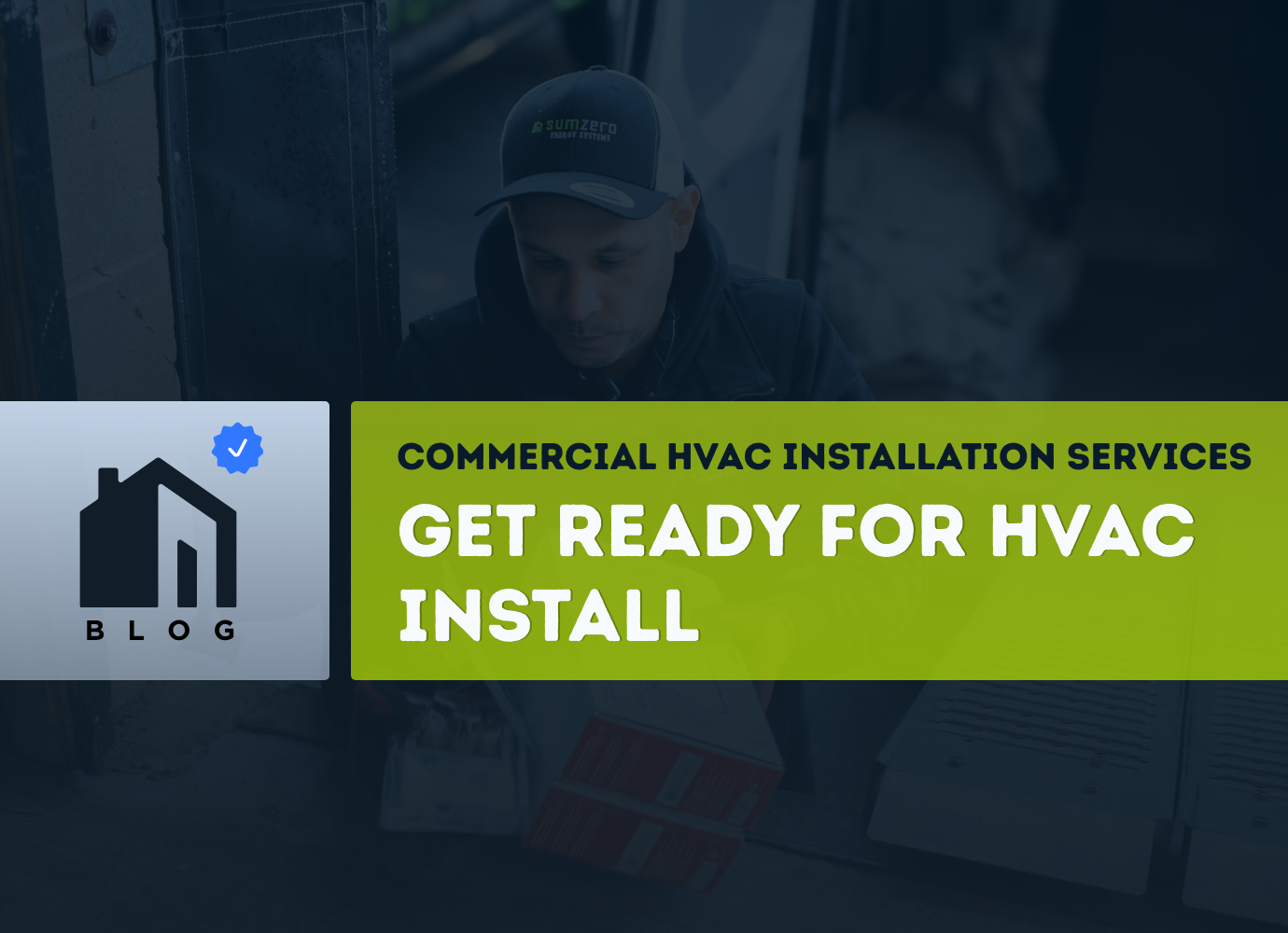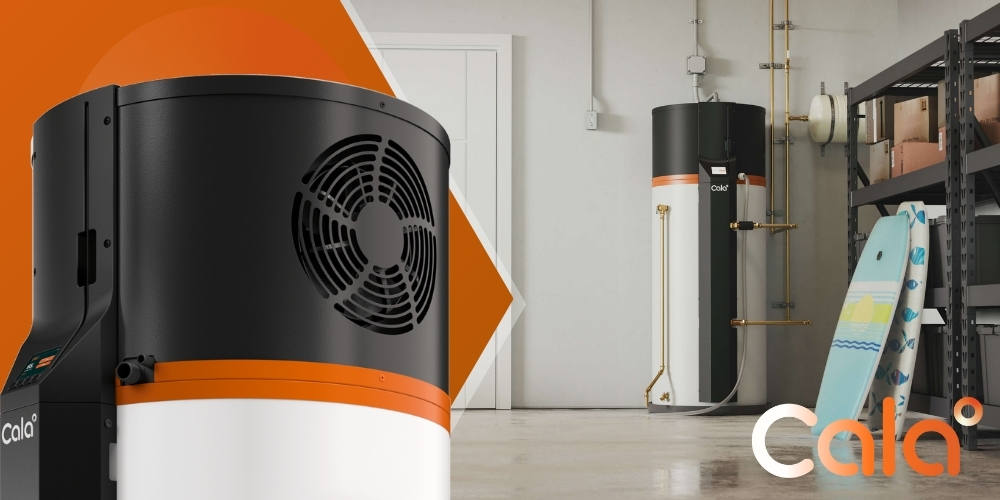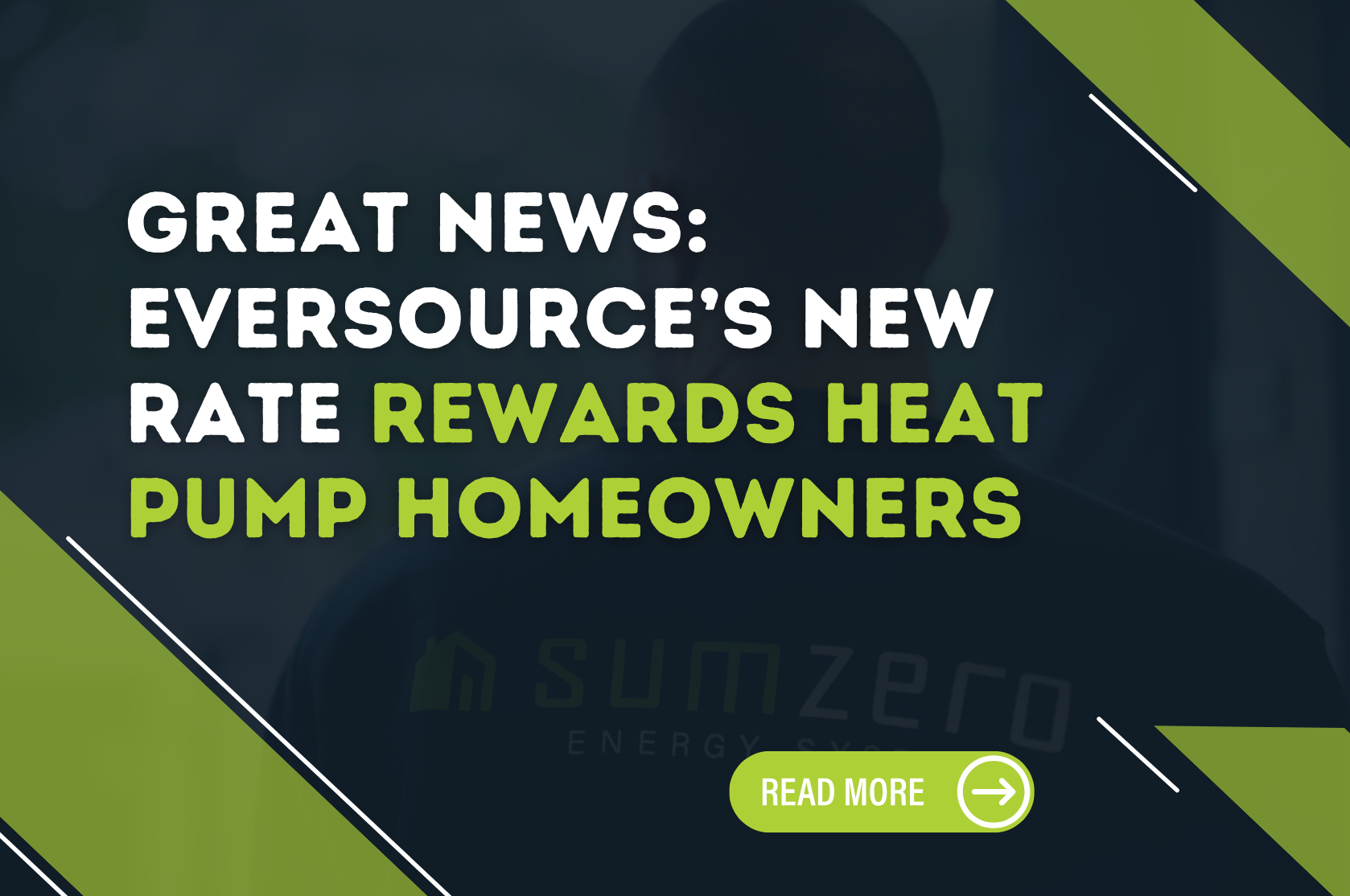What to Expect During a Commercial HVAC Installation Project

Intelligent Heat Pump Water Heaters for Massachusetts Residential Homes — Why SumZero Selects Cala
By SumZero Energy Systems — Massachusetts’ #1 Heat Pump Installation Team
Picking a new water heater once involved a simple decision between gas and standard old electric, praying the hot water wouldn't be gone when there were two showers in a row. That's no longer the case. Now, the ideal solution for the majority of Massachusetts homes is a smart heat pump water heater (HPWH). This isn't the typical hybrid of which you might have heard, but a rather new breed of unit that adapts to your home's schedule, accommodates your energy usage, and maintains comfort consistently while consuming a lot less energy.
When homeowners want to have it exactly right the first time, our team is discerning about what products we choose. We consider the landscape and inspect the details before determining that they might work with Cala, a company that produces a high-technology hot water heater that modern homes need: intelligent, consistent, and efficient hot water — installed properly. This article describes why this alliance matters, how the tech benefits your home, what you should expect from our installation, and the handy information (rebates, credits, fit questions) homeowners inquire about daily.
Why This Alliance Is Important
(and What It Does for You)
There are two parts to a successful hot water solution:
Great technology
A system that makes you comfortable and uses less energy.
Great installation
Design, placement, airflow, electrical, condensate handling, commissioning, and long-term support.
Cala provides a tailor-built, smart HPWH platform. SumZero provides actual-world experience so that it works perfectly in real Massachusetts homes.
Together, we provide three things homeowners report wanting:
Accurate hot water at peak periods without guessing.
Cheaper monthly energy bills without compromise on comfort.
It is a future-proof solution that addresses the trend towards greener, all-electric homes.
Simply put: We get hot water. We know how to properly install heat pump technology. This combination makes a water heater upgrade a smart, long-term decision.
The Homeowner's Dilemma That We Are
If you have had a gas or a typical electric water heater, then you know the problems:
Hot-cold swings on hectic morning routines.
Higher electricity bills than hoped for.
No real insight, no real control.
A replace cycle that is experienced as "buying the same thing again."
Typical hybrid: Heat pump water heaters perform better, yet they still react: They delay until the tank cools off, then warm it up again. Homeowners averred they desire a system which thinks ahead—a unit which is a breeze to operate, handles peak load graciously, and does not make them compromise.
They fill that gap, which is why we work with them.

Why a Smart HPWH is Different
A standard electric water heater makes heat by passing an electric element, a giant toaster coil, through the tank. A heat pump water heater does it another way: it takes heat from the air it lives in and puts it into the water. Because it costs less energy to move heat than create it, heat pump water heaters run on much less power than typical electric ones. And they avoid burning gas, venting, and pollution.
A smart HPWH goes one step further:
It adapts to your home's schedule (morning showers, nighttime laundry) and preheats when demand isn't yet high.
You can use the app to check, plan, or increase hot water whenever you want.
It has a compressor that can change speed to fit what you need (not just "on/off").
It is achievable with a mixing valve holding water at the proper warmth for improved efficiency and then providing a sustained, safe warmth for usage. This is also possible with the availability of additional warm water at peak usage times.
It goes nicely with a contemporary home — primed for solar, time-of-use, and information you can view at a glance.
Result: more stable comfort, less energy use, improved control.
Why a Smart HPWH is Different
From what is visible on-site, there are three things certain for homeowners regarding the points of Cala:
1) Ease That Is Effortless
Consistent hot water at peak use is the ultimate test. Through forecasting demand and using a mixing valve, Cala maintains a steady supply. That results in less "uh oh" when two showers coincidentally happen at once or someone turns on the dishwasher.
2) Controls That You'll Ever Use
App functionality is key when done properly. You can check if there's hot water, turn up the heat for guests, view energy usage history, or simply set it and leave. As installers, we appreciate performance data — it allows us to address little issues before large ones form.
3) Future-Ready from Day One
Massachusetts is going towards clean, electricity-based homes. Cala's strategy combines well: it is scalable for solar power and accounts for time-of-use rates when needed. If you foresee solar energy at some time, or already have it, this water heater won't stop your home from being efficient.
4) A Company That Stands Behind Its Product
Cala backs every unit with a 10-year parts warranty and 3-year labor warranty — a strong sign they stand behind both the technology and the people who install it. At SumZero, we respect that kind of commitment because it mirrors our own approach: taking care of homeowners and supporting our partners with the same level of trust and accountability.
What SumZero Offers As Your Installer
(Why It Matters)
Even the best system won't work so great if installed wrong. Our task is getting your new HPWH working perfectly inside your home, not on a drawing board. This is what our approach is:
Right-size design.
We measure how much water your home needs and discuss the high-flow fixtures, filling bathtubs, and washer usage.
Best installation and ventilation.
HPWHs require air to make the heat move. We consider the room size, doors, vents, and — when necessary — ducting solutions for high performance and low noise.
Clean handling of electricity and condensate.
Safe power, tidy routing, and a trustworthy drainage plan are essential.
Commissioning correctly.
We don't just "turn it on." We verify performance, position the mixing valve, help you with the app, and verify your comfort objectives.
Rebates, credits, and financial assistance.
Mass Save, federal 25C, and the 0% HEAT Loan (if applicable) — we'll help you with that.
We take special care.
Our teams respect your home, protect your floors, and leave the place nicer than they found it.
Aftercare you can count on. Questions years down the road? We're here. The whole concept of a smart system is long-term confidence, not a one-day installation.
Costs, Incentives, and Lifetime Value
Two parts matter here: upfront cost and operating cost.
→ It is a better unit than a standard electric or simple hybrid. Tax credits and rebates make a big difference. A lot of Massachusetts homeowners rely on the 0% HEAT Loan for easier payments.
→ Month after month, the intelligent HPWH's effectiveness is where the value lies. By transferring (not creating) heat and by scheduling heating intelligently, homeowners consistently experience significant decreases in water-heating energy consumption — particularly relative to resistance electric, and many times relative to gas or delivered fuels when full costs are factors.
If you'd like figures specific to your home (household number, showering usage, energy costs), we'll do the math at your consult and provide you with a clear estimate of payback, lifetime cost saving, and the rebates for which you qualify.
Are Smarter Heat Pump Water Heaters Good for Your Home?
It is feasible for many Massachusetts homes. We will cover:
→ Household size and routines. Families with up to about 5 people usually do well with the standard setup; we will give advice for larger families or special situations.
→ Space and ventilation. We check the space, door vents, or ducts if necessary, and ventilation so the system operates properly.
→ Location. Basements are typical, as are utility rooms. As the unit functions, it removes air that feels like a dehumidifier — a typical plus for basements.
→ Electrical. We check panel capacity and proper wiring; no installation day surprises.
→ Future plans. Now or in the future for solar? Time-of-use rates? We'll put the system on so it grows with your home.
[[cta-heatpump]]
Why Is Cala Different from "Traditional Hybrids"?
✪ Control and Convenience:
Cala integrates intelligent tech with a mixing valve to remain comfortable, even when it is busy. Most standard hybrid units have simple modes and react only when the tank becomes chilled.
✪ Care and Trust:
Performance insights help you recognize problems early on and keep you on your feet for surprises. Traditional deployments are mostly "wait and see."
✪ Timing and Efficiency:
Variable driving and improved scheduling assist in energy saving with the maintenance of comfort. Ordinary hybrids operate more often and at undesirable times.
✪ Future-Ready
The design of the Cala accommodates with solar power, intelligent homes, and plans for utilizing electricity. Most older hybrids were not built for that usage.

What to Expect with SumZero
(From the First Call Through the First Shower)
✪ Talk & Pictures
We'll first glance at your objectives and take some fast photos of the current installation: the water heating unit, panel, and surrounding room.
✪ Right-Fit Design
We fit your hot water consumption and available spaces to a design which we endorse.
✪ Chaplain: A Comprehensive
Your quote is going to be transparent, includes information for installation, accessories, and a checklist for incentives. The paperwork assistance takes care of our end.
✪ Professional Installation
Licensed, insured, and detail-orientated. We dispose of the old unit, prepare the site, install and commission a new system, and leave the site tidy.
✪ App Introduction and Instructions
You'll discover how to see hot water supply, schedule increases, and view consumption — without being "technical."
✪ Support and Help
We're your long-term partner. Got a question? You call us — that's what homeowners deserve from the #1 heat pump installation company.
Common Questions We Get
(And Easy Answers)
Smart heat pump water heaters move heat from the surrounding air into the water instead of generating heat directly. This makes them up to three to four times more efficient than standard electric models. Cala’s intelligent system takes it further — it learns your household’s patterns, preheats before busy periods, and gives you app-based control to monitor or boost hot water anytime.
Most hybrid water heaters react when the tank cools. Cala predicts when your home will need hot water and heats proactively, saving more energy while maintaining comfort. It also features a variable-speed compressor, integrated mixing valve, and performance monitoring portal, giving both homeowners and installers a smarter, more reliable experience.
Savings depend on your energy source and usage, but many Massachusetts homeowners cut their water-heating costs by 50–70% when switching to a heat pump system. Cala’s intelligent controls add even greater efficiency. Add Mass Save® rebates, federal 25C tax credits, and potential 0% HEAT Loan financing, and most families see real payback within just a few years.
Yes — most Massachusetts homes are a great fit. Cala’s 65-gallon design comfortably serves households up to five people and can prepare up to 90 gallons ahead of peak use. The system needs adequate space and airflow, similar to a dehumidifier, and our team at SumZero handles every detail — from placement and ducting to electrical and performance checks.
SumZero Energy Systems is Massachusetts’ #1 heat pump installation team, trusted for precision, transparency, and high-quality service. We manage every step — design, installation, rebate paperwork, app setup, and long-term maintenance — so homeowners enjoy smarter comfort and lasting confidence. With SumZero, you’re not just buying equipment; you’re gaining a partner who stands behind it.
Why We Feel Secure Recommending This to Massachusetts Homeowners
We have a simple promise: we only install solutions that we would use in our own homes. Cala’s approach — being smart, having control, and being ready for the future — matches what we have learned from many talks with homeowners in the state. Together with SumZero’s careful installation standards and ongoing support, this water-heating upgrade makes sense right away and will last well with your home. Cleaner heat. Smarter comfort. Fewer bills.
Ready to Take the Next Step?

To learn more about Cala’s technology and vision, visit Cala Systems.
Understanding the Commercial HVAC Installation Process
Starting a commercial HVAC installation project in Massachusetts can feel overwhelming. With so many factors to consider — from system type to zoning permits — it’s crucial to understand the major phases you’ll go through. A well-planned HVAC upgrade not only improves indoor comfort but can significantly cut down energy costs and maintenance headaches over time.
One of the most important things to clarify upfront is that this is a multi-stage process. Each step plays a vital role in ensuring your system is designed to meet the unique demands of your building and the unpredictable New England climate.
Initial Planning and Site Assessment
Every successful HVAC install begins long before any machinery arrives. A thoughtful planning process ensures the equipment you choose is properly sized, cost-efficient, and positioned for long-term reliability.
- Evaluate building size, insulation level, and usage patterns
- Review zoning codes and permit requirements for Massachusetts
- Choose between system types like ducted, ductless, and efficient rooftop units
- Determine energy goals — such as heating optimization or smarter zoning
One often-overlooked insight: underrating equipment size can cost more in the long run than overspending upfront. An improperly sized system will wear out faster and struggle to maintain stable temperatures.
It’s during this planning stage that you’ll lock in important decisions about airflow, cooling needs, budget, and sustainability. Whether you're retrofitting or starting fresh, this phase sets the tone for efficiency and durability.
Equipment Delivery and Preparation
Once designs are finalized and permits obtained, the next step is preparing for delivery of the HVAC units and materials. For many Massachusetts buildings, rooftop HVAC systems offer the best balance of space-saving and air circulation.
The preparation phase typically covers:
- Delivery coordination based on building access and weather conditions
- Site clearance and rooftop access inspections
- Electrical and structural requirements validation
- Pre-staging components to avoid delays
According to Mass Save®, upgrading to high-efficiency HVAC systems for businesses can lower energy usage by up to 30% when combined with professional planning and weatherproofing.
This is a good time to review your disruption plan — find out what areas of your building will be impacted and for how long. Be proactive with tenant or employee communication to maintain safe working conditions during the transition.
[[cta-heatpump]]
Installing Your Commercial HVAC System
With preparation complete, the real work begins. The installation phase typically takes several days to a few weeks depending on the building size and scope. While the timeline can fluctuate due to weather or unexpected findings, following a methodical process keeps the project on track.
Placement of Major System Components
At this point, large mechanical equipment gets positioned, secured, and connected. Rooftop units are installed using mobile cranes, while ducted systems may require access through ceiling tiles, attics, or utility spaces.
Key activities include:
- Mounting air handlers and compressing units on supports
- Sealing roof penetrations to prevent future water leaks
- Integrating with the existing or new ventilation system
- Connecting line sets and drain lines
You might notice teams working around the clock to minimize disruptions in busier locations — especially during off-peak hours for retail or healthcare centers.
Electrical and Control Connections
Modern ducted commercial HVAC systems rely on smart thermostats, zoning controls, and environmental sensors for maximum comfort and cost savings. During installation, your chosen systems will be wired to support automated scheduling, remote access, and energy monitoring.
Electrical work typically includes:
- Routing power supplies to major HVAC components
- Verifying voltage compatibility and circuit integrity
- Setting up programmable thermostats or building management integration
A growing trend in Massachusetts is pairing HVAC upgrades with energy-recovery ventilators (ERVs) to boost indoor air quality and reduce heating demands during cold months.
Once powered, your system is fine-tuned for pressure levels, air distribution, and airflow balance. The final electrical tests ensure that the system runs safely before entering the commissioning phase.
Final Inspection and Ongoing Optimization
Once the physical work is done, the final stretch focuses on testing, fine-tuning, and compliance. This last phase is what elevates a basic install to a long-lasting comfort solution tailored to your specific needs.
Commissioning and System Testing
During commissioning, HVAC teams evaluate performance using diagnostic tools and real-time system feedback. Adjustments are made to airflow settings, refrigerant levels, and motor timing.
Checklist activities include:
- Checking airflow at every vent and return
- Calibrating sensors and thermostats
- Verifying programmable settings and zoning schedules
- Ensuring temperature consistency across zones
It’s normal to find a few things that need adjusting after the first full system run — that's part of a good commissioning process.
Final Inspection and Permit Approval
Before a system is fully considered complete, most Massachusetts towns require a signed-off inspection. Inspectors confirm that:
- The HVAC system complies with local energy codes
- Rooftop units are secure and waterproofed
- Combustible clearance zones are respected
- Ventilation and indoor air quality meet building code
Once inspection is passed, a final approval notice is issued and any project documentation — including manuals and warranty certificates — is handed over.
Smart planning during a commercial HVAC install can add 10-15 years of reliable use, while skipping inspections can lead to problems that void warranties or violate building codes.
Planning for Long-Term Efficiency
It’s easy to celebrate once the HVAC system is in place, but longevity and efficiency require ongoing attention. Regular maintenance checks, filter changes, and seasonal tune-ups keep things running smoothly. Massachusetts homeowners can also look into annual rebates and optimization programs offered by Mass Save® to maximize system benefits and energy savings.
Final tip: request a full training walkthrough for whoever manages your facility or controls the thermostats. Understanding how to monitor your HVAC systems for businesses empowers better decisions — and fewer emergency calls when temperatures drop below zero.
By staying informed and involved from the first conversation to post-install maintenance, Massachusetts building owners can ensure their investment brings real value for years to come.
Maximize comfort and energy efficiency with expert commercial HVAC installation tailored for Massachusetts businesses—visit our service page to start saving with a smarter system today.
Get Commercial HVAC InstalledYou Might Also Like…
Continue learning with handpicked articles that inform and inspire.
Not Sure Where to Start? We’ll Guide You
Let our experts design the right heating and cooling solution—customized for your comfort, your layout, and your energy goals. No pressure. Just clarity.
Request FREE ESTIMATE








